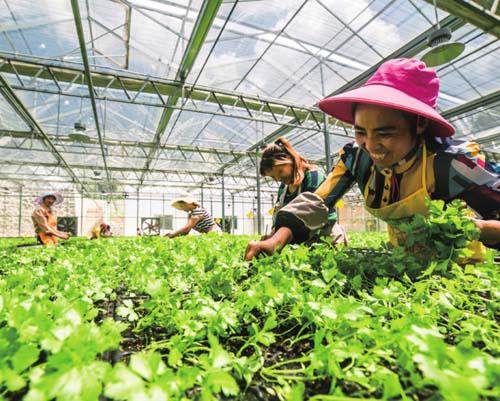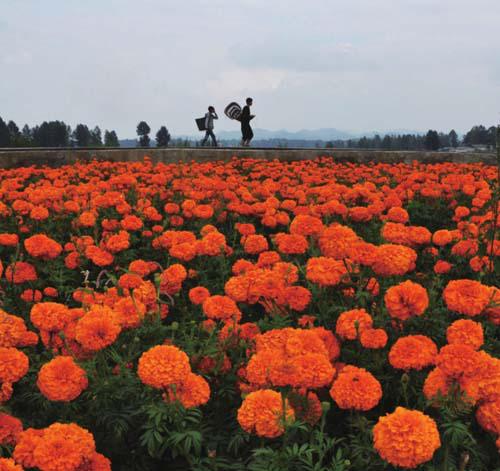Turn of Fortune
2018-09-11ByWangHairong
By Wang Hairong


Chengmanyuan, a village in Bijie City in southwest Chinas Guizhou Province, has orchards brimming with orange trees that live up to its name in Chinese. Ripe oranges, like little lanterns, dangle from lush green trees flanking houses, in the valley by the Chishui River and on the slopes of surrounding hills.
“We have different varieties of oranges that ripen at different times of the year,”said village head Zhang Anfu, who is in his early 50s. “Whatever day you come to the village, you will have fresh oranges to eat.”
The village now boasts 500 hectares of fruit trees, with nearly half covered by orange trees and the rest with plum, peach and pear trees. Fruit trees not only make the village picturesque but also fetch an impressive income for its residents.
Last year, the average per-capita net income of the village reached 10,600 yuan($1,536), Zhang said. Now, many families live in stylish houses and some own cars.
Over the last three decades, peoples living standard in Bijie has improved remarkably. Local offi cial statistics show that during that period, the citys poverty ratio plunged from 65.1 to 8.89 percent, while 5.94 million people have moved out of poverty. Recently, while commenting on this, President Xi Jinping said that Bijie has set a vivid example for poverty alleviation.
Money trees
Three decades ago, Chengmanyuan Village, then known as Nanguan Village, was in dire poverty. Crop planting was the villages mainstay while fruit trees were a side enterprise. Moreover, the trees were not of high-yielding varieties.
In the karst region, agriculture is hampered by thin and poor soil and is vulnerable to drought because the soil can barely hold water. “In the past, after three hours of rain, mudslides would occur, while after three rainless days, crop failure would ensue,” Zhang said.
He recalled that a patch of land that he and his father cultivated on a slope by the Chishui River was often ravaged by fl oods or droughts. After he managed to level off a plot of terraced land, a summer storm fol- lowed by a mountain torrent washed away one third of the soil. The remaining corn stalks, after surviving a drought that lasted for about 50 days, did not produce enough corn to feed his family for half a year.
Villagers to live in thatched houses that could hardly shelter them from wind or rain. Children in extremely poor families were often malnourished.
Changes started in 1988 when Bijie was designated as a poverty alleviation pilot area. Experts were sent by the government to guide agricultural production. After onsite inspections, the experts advised the village to plant more fruit trees and introduced high-yielding varieties into the area.
“With support from various levels of government, reservoirs began to be built on the hilltops of Chengmanyuan so water could be channeled down to irrigate fi elds,” Zhang said. “Crop land began to be converted into orchards, and fruit production became the backbone industry as new fruit species and varieties were introduced at a rapid pace and transportation was developed.”
In 2004, as orange production thrived, the village changed its name to Chengmanyuan, which literally means an“orchard overfl owing with oranges.”
In recent years, the development of transportation has brought tourists to the village for fruit picking, which has made fruit growing more lucrative. An expressway connecting Xiamen City in coastal Fujian Province with Chengdu, capital of Sichuan Province, passes through the village. The expressway, opened in late 2017, has shortened the distance between downtown Bijie and the village to one and a half hours.
“After the Xiamen-Chengdu expressway opened to traffi c, most of the oranges produced by my family were picked and purchased by guests who came to our fi eld, at a per-kilogram price that is around 1 yuan ($0.15) higher than the market price,”said villager Zhao Lianquan. In addition, Zhaos son sells fruits online.
After doing the math, Zhang estimated that visitors picking fruit in person can add more than 5 million yuan ($724,000) to the village income every year.
Rural cooperatives
While villagers in Chengmanyuan derive wealth from fruit trees, residents of Yulongba Town in Nayong County of Bijie have increased their income through planting medicinal herbs.
A rural cooperative in Yulongba has partnered with a company in Sihong County of coastal Jiangsu Province to grow chrysanthemums, with the company supplying seedlings and purchasing the fl owers.
Since late May, mum seedlings have been planted in the fields and cared for by farmers, most of whom were povertystricken residents relocated from nearby villages.
Yang Sha, a woman from the Miao ethnic group, is employed to take care of mums. She moved to Yulongba from a nearby village. Her field has been leased to the cooperative and she now works for the cooperative in return for a monthly salary of more than 2,000 yuan ($289). Lease income plus her and her husbands salaries are more than what the couple earned before from planting corn.
In recent years, Guizhou has promoted a “three-change” reform model, which means to change resources into assets, change funds into shares and change farmers into stockholders. Under this model, farmers are encouraged to voluntarily invest their own resources—including land, money and skills—in rural cooperatives in exchange for dividends and rent, and a salary if they also work for the cooperatives. This model aims to encourage land transfers and promote large-scale production and the use of new technology.
Multi-pronged approach
Bijie is one of the poorest areas in Guizhou. According to the citys government work report released in January, it still had 967,800 people living in poverty, accounting for one fourth of Guizhous poor population, and one 50th of all povertystricken people in China.
The municipal government blamed lingering poverty in the city on factors such as a low level of per-capita resources and poor agricultural infrastructure.
Bijies Mayor Zhang Jizhi explained in January that the citys population density of 347 people per km is higher than the provincial level of 252 and the national level of 144, which makes its per-capita resource level lower than the provincial and national levels. In addition, Zhang said that the citys industrial structure is not optimal. In 2017, the share of the citys primary industry to its GDP was higher than the provincial and national levels, while the ratio of its grain to cash crop output was higher than the provincial level.
The city has boosted the production of vegetables, edible fungus and medicinal herbs, and developed eco-friendly animal husbandry with poverty alleviation loans, and engaged poverty-stricken people in the production. It has also relocated people living in inhospitable areas to places with better conditions. The citys government work report showed that in 2017, resettlement housing for 135,500 people was complete.
Bijie has also created jobs including welfare-to-work positions for people living in poverty. Yu Guokun, a resident in Guantianba Community of Jinsha County got a government-assigned job to patrol and protect rivers. Yus wife is disabled and his two children are in middle and elementary schools. Although the family received a minimum-living subsidy, their finances were still strained. The job gave Yu a stable monthly income of 1,570 yuan($226). Recently, he also received training on raising chickens and was given dozens of chickens. He said he plans to raise more in the future.
Bijie has also partnered with private enterprises and economically developed regions such as Guangzhou in Guangdong Province for poverty alleviation.
More than 300 enterprises have provided assistance, including the Shenzhenbased Evergrande Group, one of Chinas top 500 companies, which has invested 11 billion yuan ($1.6 billion) for poverty alleviation in Bijie, according to the citys most recent government work report.
In 2018, the municipal government aims to achieve a 12-percent GDP growth and plans to lift 260,000 people out of poverty through various targeted measures.
